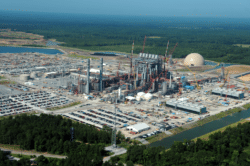A new report by Greenpeace Energy Desk reveals that one of the US’s premier coal with carbon capture and storage (CCS) demonstration plants, the Kemper County Energy Facility, is not economically viable.
The project, located in Kemper County, Mississippi, received hundreds of millions in public subsidies, promising to produce syngas through a new gasification technique in addition to utilizing waste CO2 for enhanced oil recovery (EOR) in nearby oil fields.
However, after spending $7.1 billion on the project, Kemper’s parent company is throwing in the towel on generating electricity from coal, switching instead to cheap natural gas without any carbon capture.
The Kemper County project would have been the world’s first Integrated Gasification Combined Cycle (IGCC) power plant with CCS, and was touted by industry as a pioneer for burning coal or biomass with carbon capture.
Instead, it’s become a massive, expensive failure, and an emblem of injustice – with Mississippi ratepayers potentially on the hook for up to $7 billion in cost overruns from the project.
This is big news, given that IGCC with CCS has long been promoted as the state of the art concept for CCS, including BECCS. It would have a much better energy balance than post-combustion CCS, and be the cleanest form of coal or biomass combustion possible, if it worked.
Which, of course, it doesn’t. Our takeaway is that for anyone interested in the future of CCS, the failure of Kemper County should be much bigger news than whatever may or may not happen with the Texas-based Petra Nova coal CCS plant in the future.




